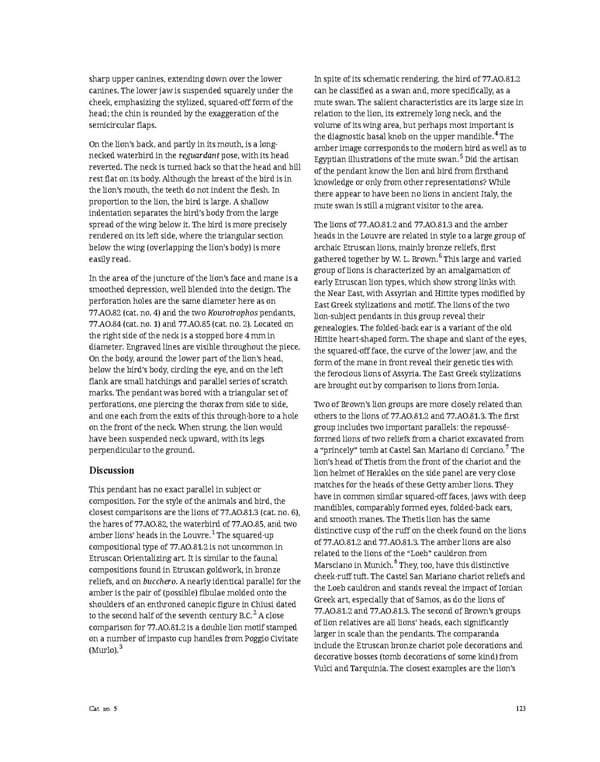sharp upper canines, extending down over the lower In spite of its schematic rendering, the bird of 77.AO.81.2 canines. The lower jaw is suspended squarely under the can be classified as a swan and, more specifically, as a cheek, emphasizing the stylized, squared-off form of the mute swan. The salient characteristics are its large size in head; the chin is rounded by the exaggeration of the relation to the lion, its extremely long neck, and the semicircular flaps. volume of its wing area, but perhaps most important is the diagnostic basal knob on the upper mandible.4 The On the lion’s back, and partly in its mouth, is a long- amber image corresponds to the modern bird as well as to necked waterbird in the reguardant pose, with its head Egyptian illustrations of the mute swan.5 Did the artisan reverted. The neck is turned back so that the head and bill of the pendant know the lion and bird from firsthand rest flat on its body. Although the breast of the bird is in knowledge or only from other representations? While the lion’s mouth, the teeth do not indent the flesh. In there appear to have been no lions in ancient Italy, the proportion to the lion, the bird is large. A shallow mute swan is still a migrant visitor to the area. indentation separates the bird’s body from the large spread of the wing below it. The bird is more precisely The lions of 77.AO.81.2 and 77.AO.81.3 and the amber rendered on its left side, where the triangular section heads in the Louvre are related in style to a large group of below the wing (overlapping the lion’s body) is more archaic Etruscan lions, mainly bronze reliefs, first easily read. gathered together by W. L. Brown.6 This large and varied group of lions is characterized by an amalgamation of In the area of the juncture of the lion’s face and mane is a early Etruscan lion types, which show strong links with smoothed depression, well blended into the design. The the Near East, with Assyrian and Hittite types modified by perforation holes are the same diameter here as on East Greek stylizations and motif. The lions of the two 77.AO.82(cat. no. 4) and the two Kourotrophos pendants, lion-subject pendants in this group reveal their 77.AO.84(cat. no. 1) and 77.AO.85 (cat. no. 2). Located on genealogies. The folded-back ear is a variant of the old the right side of the neck is a stopped bore 4 mm in Hittite heart-shaped form. The shape and slant of the eyes, diameter. Engraved lines are visible throughout the piece. the squared-off face, the curve of the lower jaw, and the On the body, around the lower part of the lion’s head, form of the mane in front reveal their genetic ties with below the bird’s body, circling the eye, and on the left the ferocious lions of Assyria. The East Greek stylizations flank are small hatchings and parallel series of scratch are brought out by comparison to lions from Ionia. marks. The pendant was bored with a triangular set of perforations, one piercing the thorax from side to side, Two of Brown’s lion groups are more closely related than and one each from the exits of this through-bore to a hole others to the lions of 77.AO.81.2 and 77.AO.81.3. The first on the front of the neck. When strung, the lion would group includes two important parallels: the repoussé- have been suspended neck upward, with its legs formed lions of two reliefs from a chariot excavated from perpendicular to the ground. a “princely” tomb at Castel San Mariano di Corciano.7 The Discussion lion’s head of Thetis from the front of the chariot and the lion helmet of Herakles on the side panel are very close This pendant has no exact parallel in subject or matches for the heads of these Getty amber lions. They composition. For the style of the animals and bird, the have in common similar squared-off faces, jaws with deep closest comparisons are the lions of 77.AO.81.3 (cat. no. 6), mandibles, comparably formed eyes, folded-back ears, the hares of 77.AO.82, the waterbird of 77.AO.85, and two and smooth manes. The Thetis lion has the same amber lions’ heads in the Louvre.1 The squared-up distinctive cusp of the ruff on the cheek found on the lions compositional type of 77.AO.81.2 is not uncommon in of 77.AO.81.2 and 77.AO.81.3. The amber lions are also Etruscan Orientalizing art. It is similar to the faunal related to the lions of the “Loeb” cauldron from Marsciano in Munich.8 They, too, have this distinctive compositions found in Etruscan goldwork, in bronze cheek-ruff tuft. The Castel San Mariano chariot reliefs and reliefs, and on bucchero. A nearly identical parallel for the the Loeb cauldron and stands reveal the impact of Ionian amber is the pair of (possible) fibulae molded onto the Greek art, especially that of Samos, as do the lions of shoulders of an enthroned canopic figure in Chiusi dated 77.AO.81.2 and 77.AO.81.3. The second of Brown’s groups to the second half of the seventh century B.C.2 A close comparison for 77.AO.81.2 is a double lion motif stamped of lion relatives are all lions’ heads, each significantly on a number of impasto cup handles from Poggio Civitate larger in scale than the pendants. The comparanda (Murlo).3 include the Etruscan bronze chariot pole decorations and decorative bosses (tomb decorations of some kind) from Vulci and Tarquinia. The closest examples are the lion’s Cat. no. 5 123
 Ancient Carved Ambers in the J. Paul Getty Museum Page 132 Page 134
Ancient Carved Ambers in the J. Paul Getty Museum Page 132 Page 134